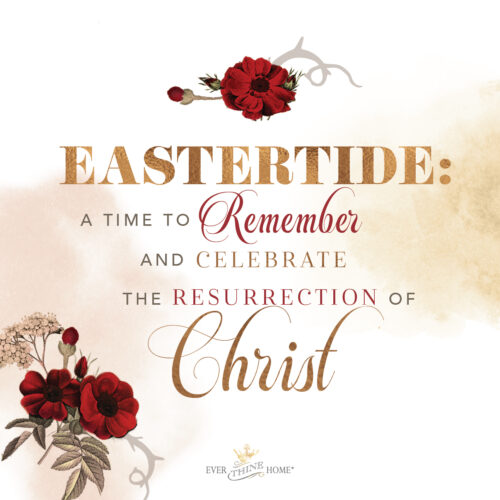
I’ve long had mixed feelings about Halloween. Yes, it’s a fun family time—especially for kids—to dress up in costumes and celebrate the fall. But in our present culture it has also become a strange celebration of horror and death … to the point where sometimes you want to turn your kids’ eyes away from the grisly costumes and decorations.
But in recent years I’ve learned more about the day after Halloween—and that’s a day worthy of our attention and our celebration.
That day is All Saints’ Day. It falls on November 1 and is meant to show gratitude to God for those believers who have gone before us. Though All Saints’ Day is not a public holiday in America, it is in many other countries.
I’d love to see more followers of Christ take advantage of this special day to remember the saints who have influenced our faith.

When we hear the word “saint,” many of us may think of people honored by the Catholic church because of their remarkable faith and works. Catholic saints are believed to have performed at least one “miracle” during their ministry.
But the Bible uses the word “saints” to describe Christians in general—those who have been saved by the blood of Christ and set apart for the sake of the gospel. 1 Peter 2:9 provides a good description: “But you are a chosen race, a royal priesthood, a holy nation, a people for his own possession, that you may proclaim the excellencies of him who called you out of darkness into his marvelous light.”
So, all of us who are born again—alive or dead—are “saints.” All Saints Day is an opportunity for saints who are alive to celebrate those saints who have touched our lives … and I think that’s a good tradition.
All Saints’ Day is a great time to tell stories. Who are some of your favorite heroes from the Bible? Who are some saints whose lives have challenged and influenced you?
One of my favorite stories about a saint who lived long ago and influenced many people is about a young teenager named, Tarore (tah’-rah-reh), who lived among the Maori people in New Zealand. In 1835 the first missionaries arrived in New Zealand. Among them were Alfred and Charlotte Brown who left their homes and family to take the story of Jesus to people who had never heard. Soon after their arrival they began a mission school to teach the Maori children to read and write in their own language. One of the first students was Tarore the daughter of Ngakuku (nah-ku-kuh), a relative of a famous chief. She was a very bright student who quickly learned to read.
Tarore’s missionary friends gave her a copy of the Gospel of Luke. Tarore treasured her book and carried it safely around her neck in a straw purse. When she returned to her tribe every evening from school, she read the stories of Jesus to anyone who would listen. With fatherly pride, Ngakuku listened to his little girl reading and soon he believed that Jesus’ way to live was better than the rules of his tribe. He gave his life to Christ to follow His way forever.
But times were troubled in the land of the Maori. Fighting was an ongoing way of life among the tribes. The Browns realized they needed to move the mission school to a safer location, and some Maori children were allowed to go with them to continue their schooling. Led by Tarore’s father, the missionaries and the children caravanned to the new location, camping along the way at night.
One evening, their cooking fires attracted the attention of a neighboring tribe. Later, when all were sleeping, warriors crept toward them intending to kill the entire group.
But when a dog barked out a warning, everyone fled into the forest. All except 12-year-old Tarore, who did not hear the barking. She alone was killed by the warriors. One of them found her little book, the Gospel of Luke, in the purse she always carried, and though he had no idea what it was, he took it.
When Ngakuku found his daughter’s body, he was overwhelmed with grief. Before he found Jesus he would have demanded “utu”—the payment of a life for a life. This law of revenge was part of the Maori tradition. Yet in his sadness he remembered the words Tarore read from Jesus: “Love your enemies” (Matthew 5:44) and “Forgive and you will be forgiven” (Matthew 6:14).
Now Ngakuku knew revenge was not the way. He resisted his desire to seek retribution against the man who killed his daughter, for the higher call to love his enemies.
Meanwhile, the warrior who stole the little book was curious about its contents, so he found someone who taught him what it said. As he listened, he too believed the words of Jesus and felt great regret that he had helped kill Tarore.
He decided to ask for forgiveness. Walking a great distance and taking a great risk that he might be killed in revenge, this warrior found both Tarore’s father and the forgiveness he needed. Their story, along with other copies of the Bible, spread among the tribes leading many to choose the way of peace that Jesus taught. Even the greatest of their chiefs became a Christian and built a church for his people.
Today, in New Zealand over 175 years later, descendants of both the Maori tribes and the white settlers learn the story of Tarore in school. They learn that it was missionaries who brought Christianity to the native people, but it was the people themselves who shared the way of forgiveness with one another.
Stories about saints like Tarore enrich our walk with Christ and challenge us to walk in obedience to God’s Word. You can probably think of saints who have influenced your life; how about telling their stories to your family?

When I think of saints who have influenced me, I could talk about two women, Sally and Pam, who led me to Christ and helped me grow in my faith as a university student over 50 years ago.
I could talk about Bill and Vonette Bright, who founded Campus Crusade for Christ (now called Cru), the organization I’ve worked with ever since I graduated from college. And I could go back even further and talk about Henrietta Mears, the remarkable woman who showed Bill how to walk with Christ when he was a young man and then led his fiancée, Vonette, to the Lord. When I look back on my spiritual heritage, I can see a straight line from Henrietta Mears to Bill and Vonette Bright to Sally and Pam and me … and then on to anyone God has used me to influence over the last few decades.
I encourage you to use All Saints’ Day to broaden your knowledge of the saints who have come before us and then to tell stories to others. These stories are part of us because we are all part of the Body of Christ. One of my favorite hymns, “Crown Him Lord of All,” ends with this stanza:
O that with yonder sacred throng
We at His feet may fall.
We’ll join the everlasting song
And crown Him Lord of all.
I look forward to the day when I will fall at the feet of Jesus and join the blessed saints of old in that “everlasting song” of praise to Him. What a day that will be!
To help you celebrate All Saints’ Day, our team here at Ever Thine Home has created some cards for you to print at home. There are five saints included in the set of cards along with some blank cards on which you can glue a photo and write the name of one or more saints who have been influential in your walk with Christ. You could pass the cards out to your family during dinner, read the short description of each, and then talk about other saints who have influenced each of you.
If you enjoyed the story of Tarore, you can read more about her and several other saints in a short book called Tales of the Resistance. It’s a collection of stories about heroes of the faith who were able to resist sin and overcome circumstances to help share the good news of Jesus with others. We have a limited number of these books left and would love to get a copy into your hands. You can order both resources through our Etsy store.





